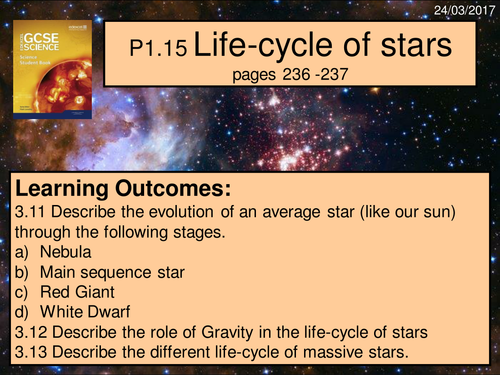
This resource contains a 21-slide theory lesson and a Kahoot Quiz as a plenary.
Slide number 1 is an introductory slide explaining the lessons learning objectives.
Slides number 2 defines Stellar Nebulae as clouds of dust and gas where stars are ‘born’.
Slide number 3 explains how Stellar Nebulae collapse due to gravity to form a protostar.
Slide 4 looks at Main sequence stars and explains how our sun is a main sequence star.
Slide 5 & 6 look at what happens when the core of a main sequence star runs out of hydrogen and then helium to become less bright; forming a red giant.
Slide 7 shows that when a red giant finally collapses then its outer layers shed off and the remains are called a white dwarf.
Slide 8 shows that the outer layers of the red giant that drift off into space become planetary nebulae.
Slide 9 looks at the different life-cycle of massive stars and begins by comparing the relative sizes of some known stars.
Slide 10 and 11 show how massive stars become red super-giants – using Betelgeuse in the constellation of Orion as an example.
Slide 12 looks at what happens when Red Super-giant stars start to die.
Slide 13-15 looks at Supernova’s - the death of Red Super-giant stars.
Slide 16 and 17 look at the two possible outcomes post supernova. Giant stars become either a Neutron star or a Black hole (depending on the size of the giant star).
Slide 18 and 19 are much needed summaries of both Star life-cycles.
Slide 20 is the book-work reference with two hyperlinked you tube videos of Stars life cycles.
Slide 21 contains the hyperlink to a Kahoot Quiz based upon this lesson
Slide 22 contains the image credits.
If you liked this lesson, please don't forget to review it and feel free to browse my shop where there are a few more.
Slide number 1 is an introductory slide explaining the lessons learning objectives.
Slides number 2 defines Stellar Nebulae as clouds of dust and gas where stars are ‘born’.
Slide number 3 explains how Stellar Nebulae collapse due to gravity to form a protostar.
Slide 4 looks at Main sequence stars and explains how our sun is a main sequence star.
Slide 5 & 6 look at what happens when the core of a main sequence star runs out of hydrogen and then helium to become less bright; forming a red giant.
Slide 7 shows that when a red giant finally collapses then its outer layers shed off and the remains are called a white dwarf.
Slide 8 shows that the outer layers of the red giant that drift off into space become planetary nebulae.
Slide 9 looks at the different life-cycle of massive stars and begins by comparing the relative sizes of some known stars.
Slide 10 and 11 show how massive stars become red super-giants – using Betelgeuse in the constellation of Orion as an example.
Slide 12 looks at what happens when Red Super-giant stars start to die.
Slide 13-15 looks at Supernova’s - the death of Red Super-giant stars.
Slide 16 and 17 look at the two possible outcomes post supernova. Giant stars become either a Neutron star or a Black hole (depending on the size of the giant star).
Slide 18 and 19 are much needed summaries of both Star life-cycles.
Slide 20 is the book-work reference with two hyperlinked you tube videos of Stars life cycles.
Slide 21 contains the hyperlink to a Kahoot Quiz based upon this lesson
Slide 22 contains the image credits.
If you liked this lesson, please don't forget to review it and feel free to browse my shop where there are a few more.
Get this resource as part of a bundle and save up to 67%
A bundle is a package of resources grouped together to teach a particular topic, or a series of lessons, in one place.
Something went wrong, please try again later.
This resource hasn't been reviewed yet
To ensure quality for our reviews, only customers who have purchased this resource can review it
Report this resourceto let us know if it violates our terms and conditions.
Our customer service team will review your report and will be in touch.
£3.00
